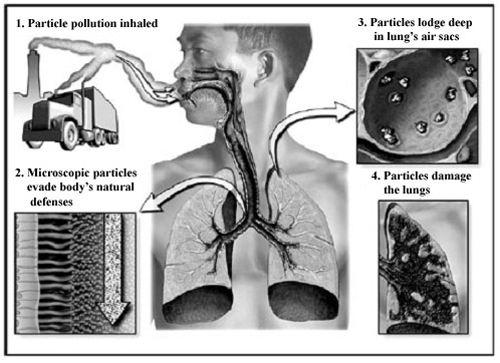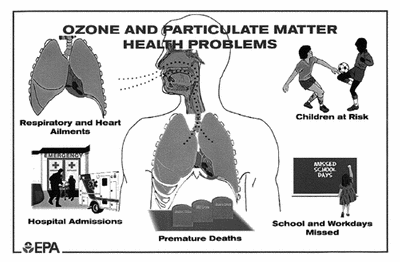Diesel engines power most of the nation's trucks, buses, trains, ships, and off-road equipment. But each diesel engine can produce tons of air pollutants over its lifetime. With mounting evidence that diesel exhaust poses major health hazards, reducing diesel pollution has become a public priority.
Health Impacts
 Diesel-powered vehicles and equipment account for nearly half of all nitrogen oxides (NOx) and more than two-thirds of all particulate matter (PM) emissions from US transportation sources.
Diesel-powered vehicles and equipment account for nearly half of all nitrogen oxides (NOx) and more than two-thirds of all particulate matter (PM) emissions from US transportation sources.
Particulate matter or soot is created during the incomplete combustion of diesel fuel. Its composition often includes hundreds of chemical elements, including sulfates, ammonium, nitrates, elemental carbon, condensed organic compounds, and even carcinogenic compounds and heavy metals such as arsenic, selenium, cadmium and zinc.¹ Though just a fraction of the width of a human hair, particulate matter comes in many sizes, from coarse particulates (less than 10 microns in diameter) to fine particulates (less than 2.5 microns) to ultrafine particulates (less than 0.1 microns). Ultrafine particulates, which are small enough to penetrate the cells of the lungs, make up 80-95% of diesel soot pollution.
Particulate matter irritates the eyes, nose, throat, and lungs, contributing to respiratory and cardiovascular illnesses and even premature death. Although everyone is susceptible to diesel soot pollution, children, the elderly, and individuals with preexisting respiratory conditions are the most vulnerable. Researchers estimate that, nationwide, tens of thousands of people die prematurely each year as a result of particulate pollution. Diesel engines contribute to the problem by releasing particulates directly into the air and by emitting nitrogen oxides and sulfur oxides, which transform into "secondary" particulates in the atmosphere.
 Diesel emissions of nitrogen oxides contribute to the formation of ground level ozone, which irritates the respiratory system, causing coughing, choking, and reduced lung capacity. Ground level ozone pollution, formed when nitrogen oxides and hydrocarbon emissions combine in the presence of sunlight, presents a hazard for both healthy adults and individuals suffering from respiratory problems. Urban ozone pollution has been linked to increased hospital admissions for respiratory problems such as asthma, even at levels below the federal standards for ozone.
Diesel emissions of nitrogen oxides contribute to the formation of ground level ozone, which irritates the respiratory system, causing coughing, choking, and reduced lung capacity. Ground level ozone pollution, formed when nitrogen oxides and hydrocarbon emissions combine in the presence of sunlight, presents a hazard for both healthy adults and individuals suffering from respiratory problems. Urban ozone pollution has been linked to increased hospital admissions for respiratory problems such as asthma, even at levels below the federal standards for ozone.
Diesel exhaust has been classified a potential human carcinogen by the U.S. Environmental Protection Agency (EPA) and the International Agency for Research on Cancer. Exposure to high levels of diesel exhaust has been shown to cause lung tumors in rats, and studies of humans routinely exposed to diesel fumes indicate a greater risk of lung cancer. For example, occupational health studies of railroad, dock, trucking, and bus garage workers exposed to high levels of diesel exhaust over many years consistently demonstrate a 20 to 50 percent increase in the risk of lung cancer or mortality.
Notes: